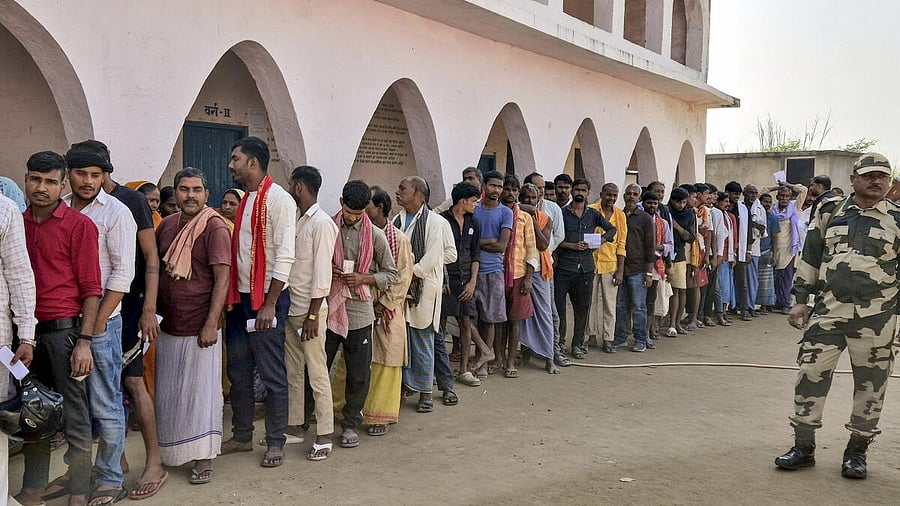
Security personnel keeps vigil as voters wait in a queue to cast votes at a polling station during the first phase of the Bihar Assembly elections, at Hajipur in Vaishali, Thursday, Nov. 6, 2025.
Credit: PTI Photo
Patna: Soon after the first phase of elections concluded in Bihar, covering 121 of the 243 constituencies, the Election Commission announced a record turnout of 64.69%.
The EC had reason to celebrate. This was the highest participation since the first polls of 1951-52. Thursday’s figure even surpassed the 62.57% turnout recorded during the 2000 Assembly elections in undivided Bihar, when the state had 324 seats.
But while the EC’s morale is buoyed by the record turnout, political parties across the spectrum are left uneasy, wondering what the surge in voter participation might signify.
The ruling party insists that the record turnout signals strong support from women voters — just as in 2015 and 2020 — in favour of the NDA in general and Nitish Kumar in particular. The Opposition, however, claims the surge reflects a groundswell against Nitish, with voters demanding a change in the regime.
“In 2015, 60.48% of women voted compared to 53.32% of men. In 2020 too, 56.69% of women turned out against 54.45% of men. On both occasions, when women outnumbered men, Nitish became chief minister. This time, his welfare measures for women, including the recent Rs 10,000 cash transfer, have once again drawn women in droves to vote for the NDA,” said a senior ruling party leader.
However, Mahagathbandhan’s chief ministerial candidate Tejashwi Yadav offers a different reading.
“Our Mai-Behan Yojna for women promises Rs 30,000 annually (Rs 2,500 per month) beginning January 14, on the auspicious day of Makar Sankranti. This has encouraged women to vote for the Mahagathbandhan. Besides, the youth, many casting their ballots for the first time, seem to be rooting for a new government that will provide jobs and curb migration. The record turnout reflects a vote for change,” he said.
Expert view
Political experts believe the record turnout is due to three key factors.
“The primary reason is the Special Intensive Revision (SIR) conducted in Bihar, which reduced the voter numbers from 7.9 crore to 7.4 crore. Once bogus voters were weeded out, the polling percentage naturally rose,” explained Giridhar Jha, editor of a national magazine.
He offered a simple calculation. “Earlier, if 60 out of 100 voters cast their ballot, the turnout was 60%. After SIR, if 10 bogus names were removed, then 60 votes out of 90 valid voters would translate into a turnout of 66.66%,” he said.
The second major factor is timing. The polls were held soon after the Chhath festival, when migrants traditionally return to Bihar. “This time, many of them stayed back to cast their vote,” noted Jha, adding that whether these voters supported the ruling camp, the Opposition alliance or Prashant Kishor’s Jan Suraaj will only be clear once the results are declared.
The third factor is the pleasant November weather. “Lok Sabha elections are usually conducted in the sultry summer months of April and May, while Assembly polls fall in November. Weather makes a huge difference to voter turnout,” said a political scientist.